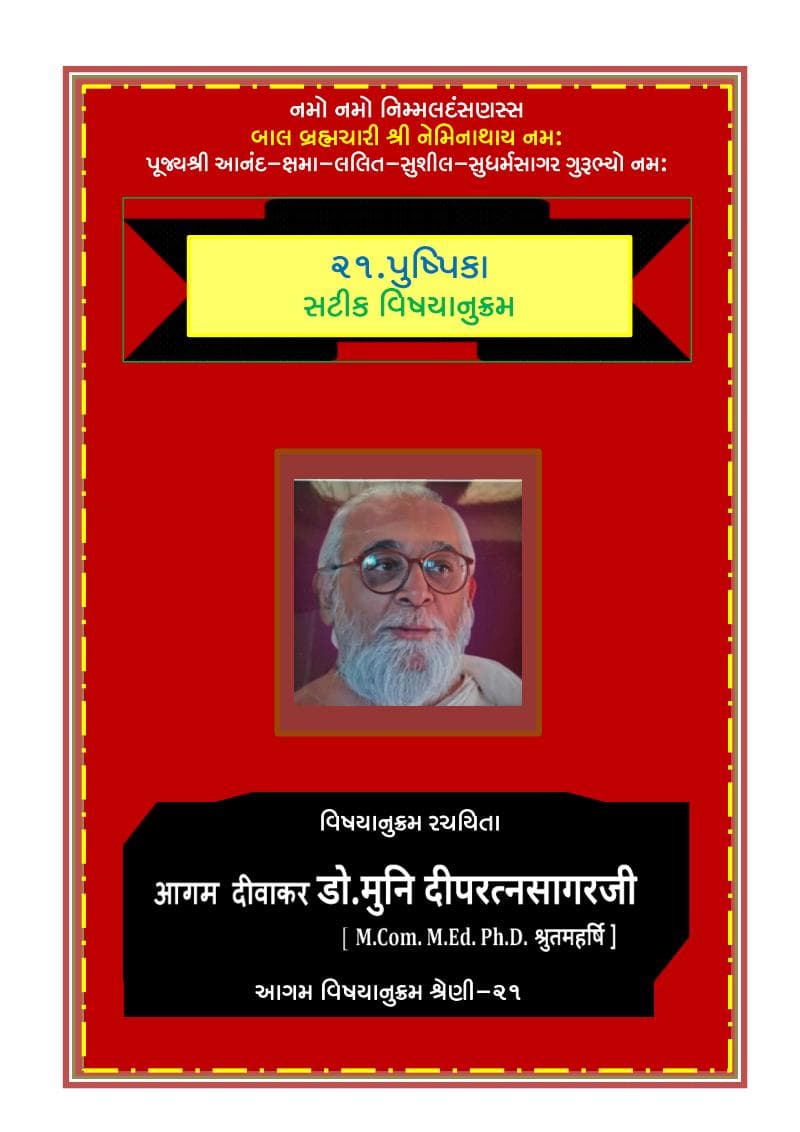21 Pushpika Satik Vishayanukram
Added to library: September 1, 2025

Summary
This is a comprehensive summary of the Jain text "21 Pushpika Satik Vishayanukram" by Dipratnasagar and Deepratnasagar, based on the information available through the provided catalog link.
Book Title: 21 Pushpika Satik Vishayanukram Author(s): Dipratnasagar, Deepratnasagar Publisher: Dipratnasagar, Deepratnasagar Catalog Link: https://jainqq.org/explore/033921/1
General Overview:
"21 Pushpika Satik Vishayanukram" is a Jain text that appears to be a commentary or elucidation (Satik) of 21 "Pushpika" texts. The title itself translates to "21 Pushpika with Commentary, Subject Index." The term "Pushpika" in Jain tradition often refers to introductory verses, summaries, or preliminary explanations of larger works, often used to encapsulate the essence of a scripture or philosophical concept. Therefore, this book likely provides detailed explanations and contextualization for a collection of 21 such introductory or summary texts.
Key Elements and Potential Content:
Based on the title and general understanding of Jain literature:
- Focus on 21 Specific "Pushpika" Texts: The core of the book is dedicated to analyzing and explaining 21 distinct "Pushpika" texts. These are likely either 21 independent Pushpika compositions or, more probably, the Pushpika sections from 21 different significant Jain scriptures.
- Commentary (Satik): The crucial aspect of this work is the "Satik" (commentary) provided by the authors. This means that for each of the 21 Pushpika texts, Dipratnasagar and Deepratnasagar offer their interpretations, explanations, and analyses. This commentary would likely:
- Clarify the meaning: Unpack the intricate philosophical and religious meanings embedded in the Pushpika verses.
- Provide context: Explain the origin and significance of each Pushpika within its parent scripture or tradition.
- Elaborate on concepts: Expand on the key Jain principles, vows, karma, spiritual stages, or other doctrines that the Pushpika might be alluding to.
- Discuss their importance: Highlight why these specific Pushpikas are considered essential or foundational.
- Subject Index (Vishayanukram): The inclusion of a "Vishayanukram" indicates that the book is well-organized. This subject index would likely:
- Categorize the topics: Group the various themes and concepts discussed within the 21 Pushpikas and their commentaries.
- Facilitate research: Allow readers to easily locate specific subjects or chapters of interest within the book.
- Provide an overview of the content: Offer a structured glimpse into the breadth of topics covered.
- Authorship by Dipratnasagar and Deepratnasagar: The dual authorship suggests a collaborative effort, possibly with one author focusing on the original Pushpika texts and the other on the commentary, or a joint effort in interpreting and presenting the material. These authors are likely respected scholars or spiritual leaders within the Jain tradition.
- Publisher: The fact that the authors are also the publishers suggests either an independent scholarly publication or a dedicated initiative to disseminate this specific Jain knowledge.
Potential Themes and Significance:
Given the nature of "Pushpika" texts in Jainism, the commentary would likely delve into foundational Jain philosophical concepts such as:
- The Tattvas (Realities): The six fundamental categories of existence in Jainism (Jiva, Ajiva, Punya, Pap, Asrava, Samvara, Nirjara, Bandha, Moksha).
- The Three Jewels (Triratna): Right Faith (Samyak Darshan), Right Knowledge (Samyak Gyan), and Right Conduct (Samyak Charitra), which are essential for liberation.
- Ahimsa (Non-violence): The paramount principle of Jainism, and its various applications.
- Karma Theory: The intricate science of action and its consequences in Jainism.
- The Path to Liberation (Moksha): The steps and practices leading to spiritual freedom.
- The Great Vows (Mahavratas) and Minor Vows (Anuvratas): Ethical principles for monks and lay followers.
- The Fourfold Community (Chaturth Sanga): Monks, nuns, laymen, and laywomen.
- The Nature of the Soul (Jiva): Its eternal, conscious, and potentially liberated nature.
The significance of this book lies in its potential to:
- Demystify complex Jain doctrines: By providing detailed explanations of introductory texts, it can make profound spiritual concepts more accessible to a wider audience.
- Preserve and transmit Jain knowledge: It contributes to the ongoing scholarly and spiritual engagement with classical Jain literature.
- Offer scholarly insights: The commentary by Dipratnasagar and Deepratnasagar would likely represent a valuable contribution to Jainology.
- Serve as a reference for study: The subject index would make it a useful resource for students, scholars, and practitioners of Jainism.
In summary, "21 Pushpika Satik Vishayanukram" is a significant Jain text that offers a detailed, commented-upon analysis of 21 introductory or summary compositions within Jain scripture. It serves to elucidate fundamental Jain principles and practices, making them more understandable and accessible through scholarly interpretation and organized presentation.